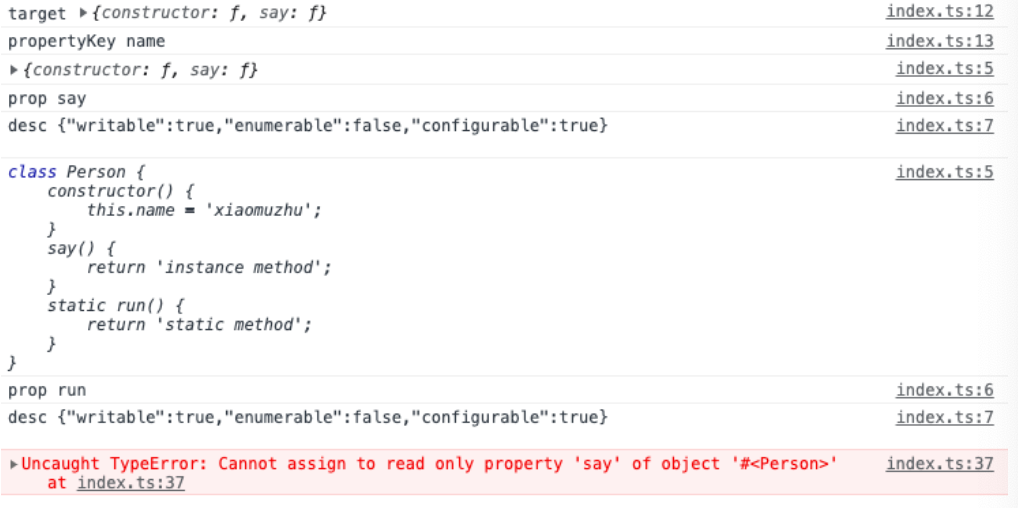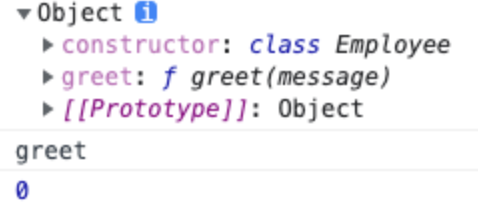Appearance
ts 装饰器
简介
装饰器是一种特殊类型的声明,它能够被附加到类声明,方法, 访问符,属性或参数上
是一种在不改变原类和使用继承的情况下,动态地扩展对象功能
同样的,本质也不是什么高大上的结构,就是一个普通的函数,@expression 的形式其实是 Object.defineProperty 的语法糖
expression 求值后必须也是一个函数,它会在运行时被调用,被装饰的声明信息做为参数传入
使用方式
由于 ts 是一个实验性特性,若要使用,需要在 tsconfig.json 文件启动,如下:
ts
{
"compilerOptions": {
"target": "ES5",
"experimentalDecorators": true
}
}typescript 装饰器的使用和 javascript 基本一致
类的装饰器可以装饰:
- 类
- 方法/属性
- 参数
- 访问器
类装饰
例如声明一个函数 addAge 去给 Class 的属性 age 添加年龄.
ts
function addAge(constructor: Function) {
constructor.prototype.age = 18
}
@addAge
class Person {
name: string
age!: number
constructor() {
this.name = 'huihui'
}
}
let person = new Person()
console.log(person.age) // 18上述代码,实际等同于以下形式:
ts
Person = addAge(function Person() { ... });上述可以看到,当装饰器作为修饰类的时候,会把构造器传递进去。 constructor.prototype.age 就是在每一个实例化对象上面添加一个 age 属性
方法/属性装饰
同样,装饰器可以用于修饰类的方法,这时候装饰器函数接收的参数变成了:
- target:对象的原型
- propertyKey:方法的名称
- descriptor:方法的属性描述符
可以看到,这三个属性实际就是 Object.defineProperty 的三个参数,如果是类的属性,则没有传递第三个参数
如下例子:
ts
// 声明装饰器修饰方法/属性
function method(target: any, propertyKey: string, descriptor: PropertyDescriptor) {
console.log(target)
console.log('prop ' + propertyKey)
console.log('desc ' + JSON.stringify(descriptor) + '\n\n')
descriptor.writable = false
}
function property(target: any, propertyKey: string) {
console.log('target', target)
console.log('propertyKey', propertyKey)
}
class Person {
@property
name: string
constructor() {
this.name = 'huihui'
}
@method
say() {
return 'instance method'
}
@method
static run() {
return 'static method'
}
}
const xmz = new Person()
// 修改实例方法say
xmz.say = function () {
return 'edit'
}输出如下所示:

参数装饰
接收 3 个参数,分别是:
- target :当前对象的原型
- propertyKey :参数的名称
- index:参数数组中的位置
ts
function logParameter(target: Object, propertyName: string, index: number) {
console.log(target)
console.log(propertyName)
console.log(index)
}
class Employee {
greet(@logParameter message: string): string {
return `hello ${message}`
}
}
const emp = new Employee()
emp.greet('hello')输出如下:

访问器装饰
使用起来方式与方法装饰一致,如下:
ts
function modification(target: Object, propertyKey: string, descriptor: PropertyDescriptor) {
console.log(target)
console.log('prop ' + propertyKey)
console.log('desc ' + JSON.stringify(descriptor) + '\n\n')
}
class Person {
_name: string
constructor() {
this._name = 'huihui'
}
@modification
get name() {
return this._name
}
}装饰器工厂
如果想要传递参数,使装饰器变成类似工厂函数,只需要在装饰器函数内部再函数一个函数即可,如下:
ts
function addAge(age: number) {
return function (constructor: Function) {
constructor.prototype.age = age
}
}
@addAge(10)
class Person {
name: string
age!: number
constructor() {
this.name = 'huihui'
}
}
let person = new Person()执行顺序
当多个装饰器应用于一个声明上,将由上至下依次对装饰器表达式求值,求值的结果会被当作函数,由下至上依次调用,例如如下:
ts
function f() {
console.log("f(): evaluated");
return function (target, propertyKey: string, descriptor: PropertyDescriptor) {
console.log("f(): called");
}
}
function g() {
console.log("g(): evaluated");
return function (target, propertyKey: string, descriptor: PropertyDescriptor) {
console.log("g(): called");
}
}
class C {
@f()
@g()
method() {}
}
// 输出
f(): evaluated
g(): evaluated
g(): called
f(): called应用场景
可以看到,使用装饰器存在两个显著的优点:
- 代码可读性变强了,装饰器命名相当于一个注释
- 在不改变原有代码情况下,对原来功能进行扩展
